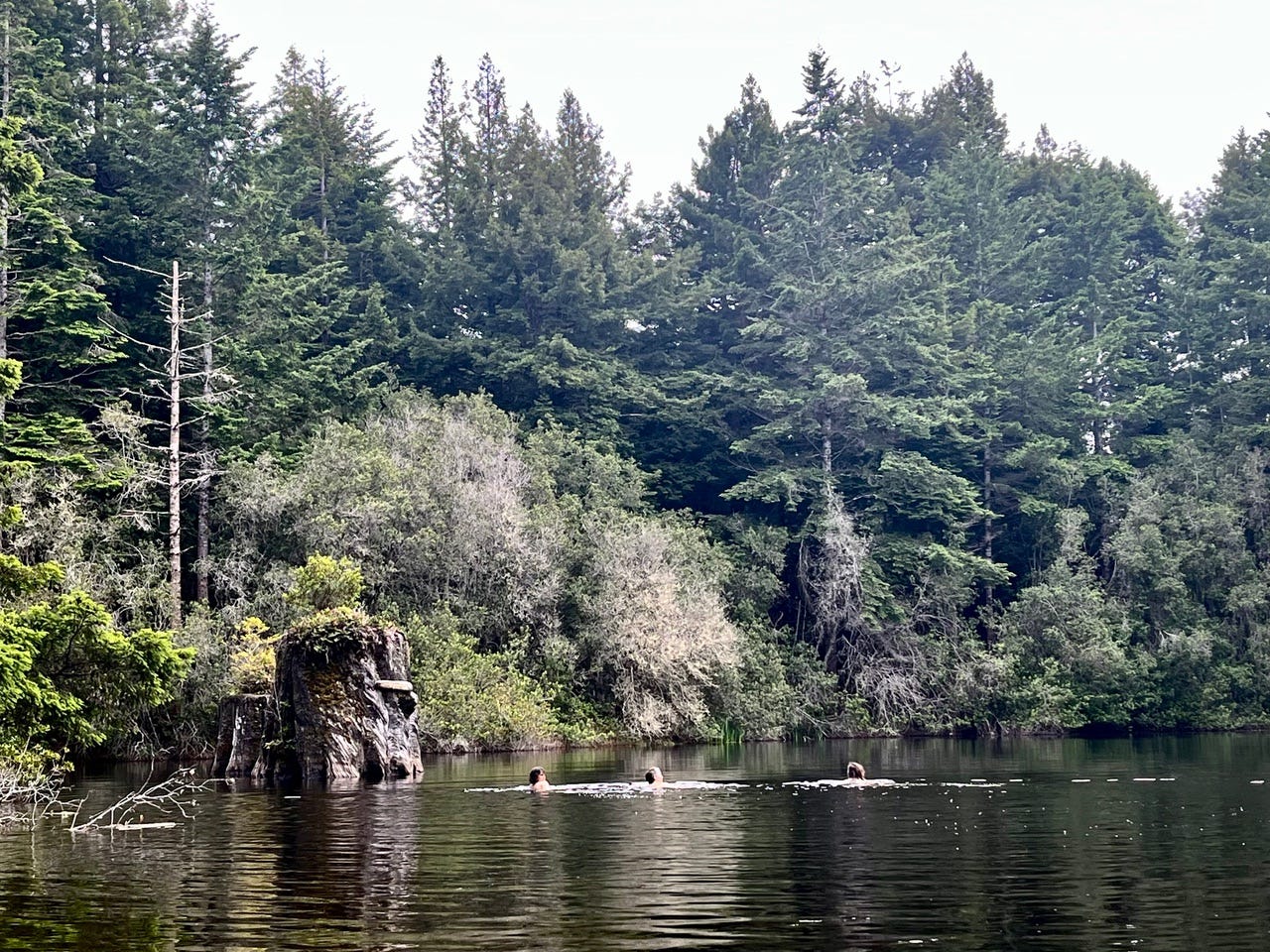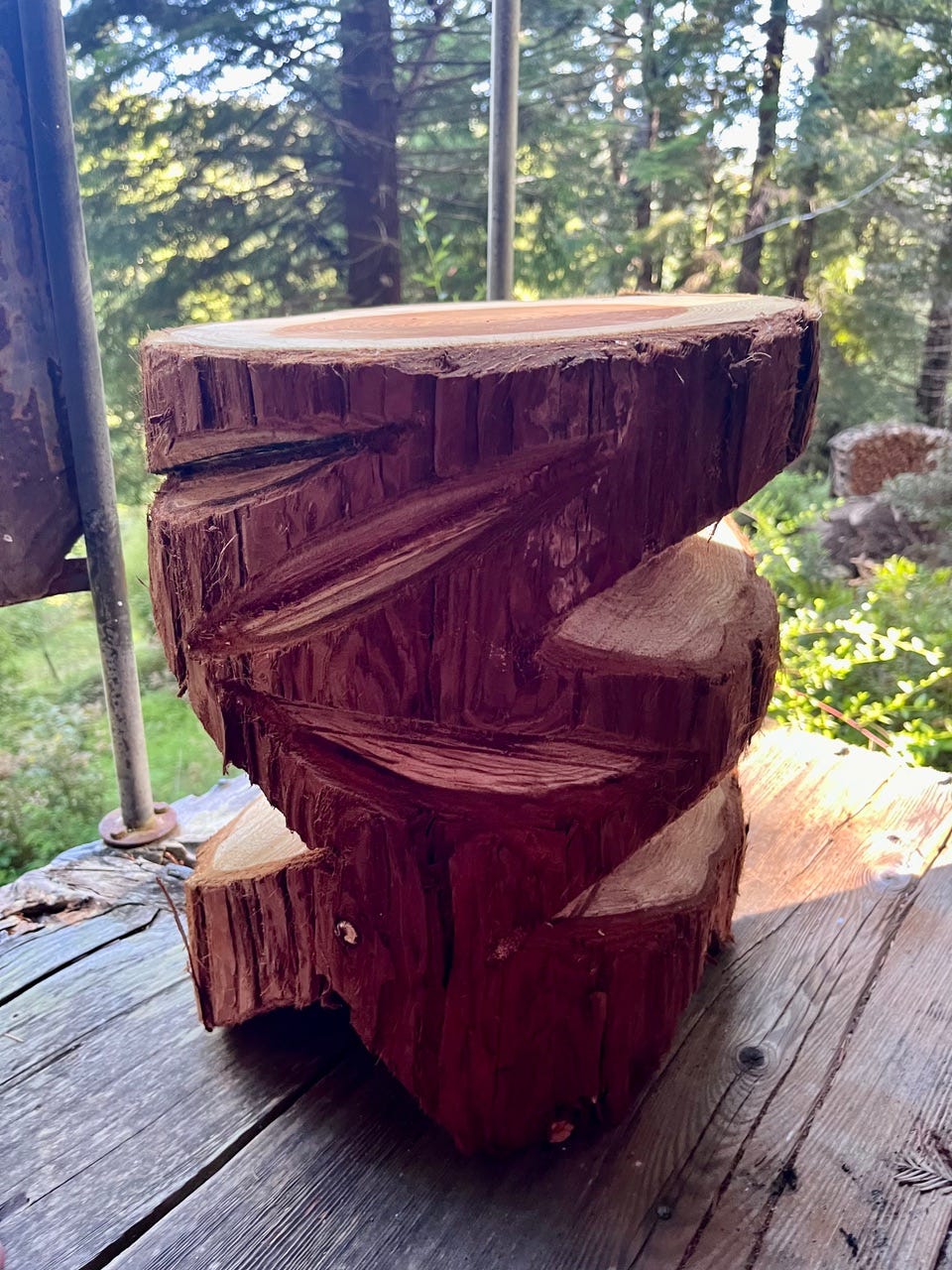“You made it! Welcome to the most peaceful place on Earth. I hope you can drop in and let the medicine from the forest bring you exactly what you need.”
-Love MK (note left to me from previous Walden cabin guest)
During my first visit to Salmon Creek Farm, I was struck by the fact that the cabins faced the woods, not each other. Sitting at my little desk in Walden Cabin, I felt a oneness with nature and a sense of solitude, yet I knew that if I stepped behind my cabin and called up the hill, a friend would respond, enveloped by a towering forest and a close-knit community. The cabin was built by an original Salmon Creek Farm communard Leona Walden in the early 1970’s. I met her for the first time at a meal in the outdoor kitchen. She told mesmerizing stories but the most enchanting thing about the evening was knowing I was sitting across the table from the woman who built (with her hands) the warm cabin I had found such solace within.
The original community members who built the cabins - Dawn, Walden, and Moonlight - that we were staying in that week joined us for the opening of our first in-person board meeting on the land. They shared stories about tending the land, sharing food, and building their homes out of scavenged wood. They remain close friends. They helped us understand the history of the place. We asked them for advice, and here are some highlights:
Be self-sufficient
Cook together
Capture southern light
Have good communication
Live in community
Later during that meal other communards spoke of a pond in the area. I made friends with some of the artists staying in Rainbow Cabin, and we set out the next afternoon to see if we could find it. When we arrived, we found a pond that stretched far enough that you couldn’t see its full perimeter. You had to squint to make out the details on the other side. The water was clear and fresh, but its depth was hard to gauge. In the middle, an old-growth redwood stump rose 15 feet out of the still water, so large it formed an island. There was a huge bird’s nest in the middle of the island that belonged to those giant white whooping cranes that seemed to swoop out of the Jurassic period. Lotus flowers bloomed beautifully on the water’s surface, and hundreds framed the circumference. I had never seen a lotus flower in real life, only in many meditations. They are prevalent in the iconography of Tibetan Buddhist visualizations, where practitioners are often instructed to imagine a deity sitting in the lotus position on top of a lotus flower. I realized that lotus flowers float like little islands in the water. In Kadampa meditations, we often imagine a lotus flower as our heart chakra, islands in the middle of our energetic bodies. Seeing this pond, with the stump of a seemingly ancient redwood creating an island ecosystem and imagining deities floating on our heart chakra and on all the water flowers, we watched two cranes floating through the air.
Soon, we were swimming. How could we not? We tested the bottom to be sure it was neither too slimy nor sharp. Initially cold, the water quickly became comfortable, then absolutely enveloping and beyond magical. We swam over to the lotus flower patch on one side to gain some confidence and then ventured out into the middle to test our courage. We knew not to climb the stump because a handmade wood-carved sign asked all guests not to, so as not to disturb the eggs in the nest.
One of the three women on this journey with us, Katrina, stayed on shore. This felt soothing because, on the walk there, she had said so many wise and insightful things that I thought she would know best what to do if the magic of the place became too much for us. Should some deity on a lotus leaf keep our attention too long, I was sure she would urge us back to shore. If the mysticism of the place allowed for some prehistoric pond monster to try to pull us away, she would surely know how to dangle a branch over to us and save the day.
When we got out, we walked and laughed. We regretted likely being late for dinner, so we walked much faster. I mentioned how amazing it would be if we had a photo to remember the moment, at which point Katrina revealed that she was a photographer and had taken some great shots while we were swimming. She offered to share the photo with me if I shared a copy of a poem I read the night before in Rainbow Cabin with the group. I still owe her a copy of that poem; she shared the photo with me almost immediately with a big grin. This brings me to my central point: trading, gifting, and currency at Salmon Creek Farm. There are four main currencies exchanged:
Art—You can trade your art with others and do very well. There is a strong gifting culture with regard to art on the land, and you are more than likely to be blessed with the gift of someone’s art upon arrival and surely before you leave.
Friendship—Friends are being made all the time. It’s less about trading in this area and more about sharing and investing.
Wood—Not only do we trade logs, we chop logs, move logs, stack logs, store logs, shave logs, burn logs, and split logs. We enjoy a consistent and loving trade partnership with nature. Stumps are particularly valuable. They are basically giant logs, and we use them for making sculptures and chairs. We actually use stumps to split wood on, making more logs. This is an example of compounding interest. When we are lucky enough to get an entire trunk, which is basically a giant stump, we use trunks to make tabletops, beams, and planks. Planks then make walls and stairs, cabin floors, and sundecks.
Food—We harvest food, carry food, plant food, grow food, cook food, clean up after cooking food, store food, pickle food, brew teas, eat food, and compost food.
As the treasurer of Salmon Creek Arts, I can’t tell you what a joy it is to spend time in a community of people who organize their lives not around money but around things like art, friendship, nature, and food. And one thing I have learned, having the great good fortune to be part of this group, is that it is surprisingly soothing to organize an entire day around chopping firewood!
by Shannon Holloway, board member and treasurer of Salmon Creek Arts
·








